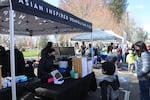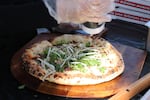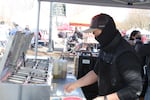
Natalie Truong greets customers under the Hapa Pizza canopy at the Beaverton Farmers Market.
Steven Tonthat / OPB
On a bustling Saturday afternoon at the Beaverton Farmers Market, Aaron Truong and his wife Natalie are busy stretching dough, slathering marinara sauce and selling whole pizzas under their Hapa Pizza canopy.
The word “hapa” comes from the Native Hawaiian definition for “half.” In the modern sense, it most commonly refers to someone who identifies as half Asian or Pacific Islander and half white, but in Hawaii, it’s used to refer to anyone of mixed race. And Aaron believes it’s the perfect way to describe his modern take on pizzas.
“We’re taking elements of both of these cultures that have influenced us and bringing them together to make something new,” Aaron says.
While Natalie takes customer orders at the front table, Aaron and three staffers, all friends and family members, operate three small pizza ovens in the back — aiming to turn out several pies as quickly as possible.
Their most popular menu item is the phở pizza. It’s topped with ingredients normally found in the iconic Vietnamese soup dish, including bean sprouts, Thai basil, braised beef brisket and a house-made special sauce.
“It’s a reduced phở broth that we’ve been able to thicken to get the sauce consistency,” explains Aaron. “The brisket is slow-cooked in the broth so that it kind of absorbs a lot of the flavor.”

The phở pizza is Hapa Pizza's most popular dish. It combines elements from the popular Vietnamese soup with a pizza foundation.
Steven Tonthat / OPB
Hapa Pizza serves other Asian-inspired dishes, all of which are farmers market favorites.
“We have a Korean barbecue pizza that takes marinated spicy Gochujang flavored pork belly that’s grilled and kimchi cucumbers that give you a fresh, refreshing flavor,” he says. “We make a banh mi pizza that has pickled daikon and radish. So it’s got this fresh crunch to it along with marinated lemongrass pork.”
In 2019, Aaron started making pizza as a hobby after he bought an oven on a whim.
“My wife was pretty mad at me for spending $500 on a pizza oven,” he says, laughing.
They hosted a party for some friends and as an experiment served pizza topped with bulgogi, Korean marinated beef.
It was an instant hit. Truong’s friends suggested that the couple try selling the bulgogi pizza at a local farmers market.
That’s when the idea struck to top pizza with even more Asian ingredients — like galbi, Korean marinated short ribs.
“Bulgogi, galbi, phở. All of the stuff that we grew up eating and liked to eat. And so when it came time to top the pizzas with whatever we wanted, it just seemed kind of like a no brainer,” he says.
Fast forward to 2020 and Aaron’s realization that his passion for cooking was quickly becoming an outlet to explore his childhood struggles with Asian identity.
Aaron, whose father is Chinese from Vietnam and mother is from Taiwan and moved to the U.S. when she was 17, grew up experiencing both Asian and American cultures and cuisines.
While living in Lake Oswego in the early 2000s, he said he often felt like he couldn’t relate to his friends and family.
“My mom had her Chinese friends and their kids and I felt like I didn’t really quite fit in with them, and then I didn’t really quite fit in with the white kids at school. So I felt really alone for much of high school.”
Incidents of racism and discrimination compounded his feelings of loneliness.
“When people would come over and make fun of the way that my mom talked or the way that our house smelled, it just really made me feel othered,” he says. “I actually tried to downplay or hide my Asianness. I would try to act as non-Asian or kind of anti-Asian as I could just to try to belong.”

Aaron Truong prepares another pizza at the Hapa Pizza canopy at the Beaverton Farmers Market.
Steven Tonthat / OPB
Aaron then went to college and spent time with other Asian Americans. That was when he finally felt connected with his roots and discovered that he isn’t necessarily just Asian or just American; he’s both.
“I realized there’s this alternative subculture where it’s a hybrid of elements of both cultures, and it just instantly felt like home,” he says.
He applied that idea to Hapa Pizza. By adding Asian ingredients to an American loved dish like pizza, Truong created a dish that isn’t fully American nor is it fully Asian; it’s a hybrid, combining the best of both.
“I grew up eating mostly Asian food. My wife is a fourth generation Asian American, so she grew up eating a lot of American food. And it just seemed like a natural byproduct of our story,” he says.
Through Hapa Pizza’s growing popularity, Aaron is able to connect with other Asian Americans in the community in ways that he never could when he was younger.
“Richard Văn Lê from Matta, Mama Dút, Portland Ca Phe, HeyDay Donuts, all these people who have become our friends. It was so uplifting to be around other Asian Americans who were leading in their own individual ways,” he says.
Lisa Nguyen owns HeyDay Donuts. Like Hapa Pizza, she’s using Asian fusion cuisine to explore and celebrate her heritage.
“We were taught to assimilate to Western American culture. I enjoy all that stuff too, but we were never taught to celebrate that other side of our culture and be excited about the food that we grew up with,” she says. “Now we’re able to do it on a really big scale and I think that’s something that probably was missing for a lot of us growing up as Asian Americans.”
She credits Hapa Pizza for showing that there is a space for Asian Americans to educate and share their culture through food.
“I know that Aaron and Natalie love what they do,” she says. “They have a huge setup that they have to do at the farmers market, and yet they sell out and that keeps us going.”
Aaron is now taking the next steps to build a permanent brick and mortar spot in Beaverton. He and his family already have roots in the community, and Aaron preferred Portland’s west side suburbs because of its established Asian American population. According to the U.S. Census Bureau, Asian Americans make up about 13% of Beaverton’s roughly 97,000 residents.
“When you think of Portland metro, it’s either in Southeast or Beaverton that has a decent amount of Asian Americans,” he says. “We really want this to be a reflection of who we are and one of our values is community and putting down roots.”
“What makes Hapa Pizza different is the reason why it’s become so popular and the thing that I was once ashamed of is what we’re most proud of now. It’s our distinct Asianness,” he says.

From left to right: Erin Hurh, Natalie Truong, Aaron Truong, Alvin Truong and Martin Lee work together to serve up Asian fusion inspired pizza at Hapa Pizza.
Steven Tonthat / OPB
